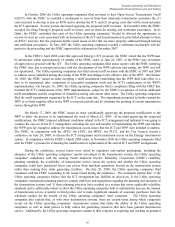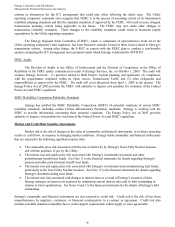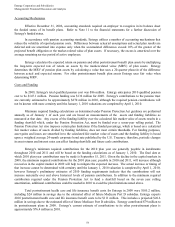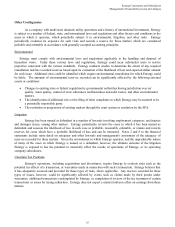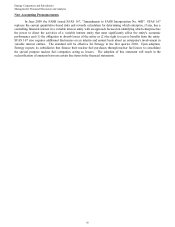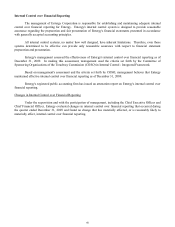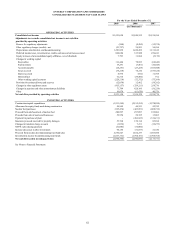Entergy 2009 Annual Report Download - page 56
Download and view the complete annual report
Please find page 56 of the 2009 Entergy annual report below. You can navigate through the pages in the report by either clicking on the pages listed below, or by using the keyword search tool below to find specific information within the annual report.
Entergy Corporation and Subsidiaries
Management's Financial Discussion and Analysis
52
Accounting Mechanisms
Effective December 31, 2006, accounting standards required an employer to recognize in its balance sheet
the funded status of its benefit plans. Refer to Note 11 to the financial statements for a further discussion of
Entergy's funded status.
In accordance with pension accounting standards, Entergy utilizes a number of accounting mechanisms that
reduce the volatility of reported pension costs. Differences between actuarial assumptions and actual plan results are
deferred and are amortized into expense only when the accumulated differences exceed 10% of the greater of the
projected benefit obligation or the market-related value of plan assets. If necessary, the excess is amortized over the
average remaining service period of active employees.
Entergy calculates the expected return on pension and other postretirement benefit plan assets by multiplying
the long-term expected rate of return on assets by the market-related value (MRV) of plan assets. Entergy
determines the MRV of pension plan assets by calculating a value that uses a 20-quarter phase-in of the difference
between actual and expected returns. For other postretirement benefit plan assets Entergy uses fair value when
determining MRV.
Costs and Funding
In 2009, Entergy's total qualified pension cost was $86 million. Entergy anticipates 2010 qualified pension
cost to be $147.1 million. Pension funding was $132 million for 2009. Entergy's contributions to the pension trust
are currently estimated to be approximately $270 million in 2010, although the required pension contributions will
not be known with more certainty until the January 1, 2010 valuations are completed by April 1, 2010.
Minimum required funding calculations as determined under Pension Protection Act guidance are performed
annually as of January 1 of each year and are based on measurements of the assets and funding liabilities as
measured at that date. Any excess of the funding liability over the calculated fair market value of assets results in a
funding shortfall which, under the Pension Protection Act, must be funded over a seven-year rolling period. The
Pension Protection Act also imposes certain plan limitations if the funded percentage, which is based on a calculated
fair market values of assets divided by funding liabilities, does not meet certain thresholds. For funding purposes,
asset gains and losses are smoothed in to the calculated fair market value of assets and the funding liability is based
upon a weighted average 24-month corporate bond rate published by the U.S. Treasury; therefore, periodic changes
in asset returns and interest rates can affect funding shortfalls and future cash contributions.
Entergy's minimum required contributions for the 2010 plan year are generally payable in installments
throughout 2010 and 2011 and will be based on the funding calculations as of January 1, 2010. The final date at
which 2010 plan year contributions may be made is September 15, 2011. Given the decline in the capital markets in
2008, the minimum required contributions for the 2010 plan year, payable in 2010 and 2011, will increase although
recoveries in the capital market in 2009 will help to mitigate the expected increase. The actual increase or timing of
that increase cannot be determined with certainty until the January 1, 2010 valuation is completed by April 1, 2010;
however Entergy’ s preliminary estimates of 2010 funding requirements indicate that the contributions will not
increase materially over and above historical levels of pension contributions. In addition to the minimum required
contribution required under the Pension Protection Act to fund a shortfall based on the seven year rolling
amortization, additional contributions could be needed in 2010 to avoid the plan limitations noted above.
Total postretirement health care and life insurance benefit costs for Entergy in 2009 were $105.2 million,
including $24 million in savings due to the estimated effect of future Medicare Part D subsidies. Entergy expects
2010 postretirement health care and life insurance benefit costs to be $111 million. This includes a projected $26.6
million in savings due to the estimated effect of future Medicare Part D subsidies. Entergy contributed $79 million to
its postretirement plans in 2009. Entergy’ s current estimate of contributions to its other postretirement plans is
approximately $76.4 million in 2010.
54



